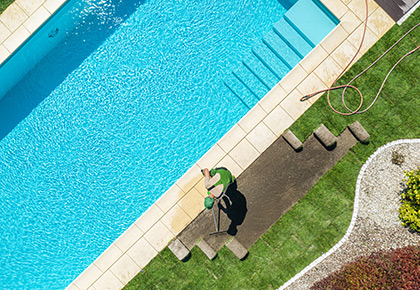Maintenance, Capital Improvements, Useful Life: Is Your HOA Prepared?
 Which components should we fix and which should we replace entirely?
Which components should we fix and which should we replace entirely?When do maintenance jobs become capital improvements?
How can you tell whether it’s maintenance or a capital improvement?
To keep your property’s assets operating smoothly and looking good, your Arizona HOA management company needs to stay on top of routine repairs and maintenance as well as major repair, replacement and upgrade projects. Understanding how these activities differ and learning how to better navigate complex topics like useful life and reserve studies is crucial when it comes to ensuring your association’s relevance in the community at large.
What’s the Difference Between Maintenance and Capital Improvements?
As a reminder, routine and preventative maintenance are classified as expenses for your HOA and come under the “Repairs & Maintenance” (R&M) line item in your budget. They are designed to restore your assets to their original condition and to prevent further deterioration so that components can reach their expected useful life. For example, activities such as touching up paint in hallways, landscaping, cleaning the pool, replacing lightbulbs that are out, repairing irrigation systems or other tasks that are performed frequently or on an ongoing basis would be classified as maintenance.
Capital improvements, on the other hand, are major repairs and replacements that increase the market value of components beyond their original or current state. Your HOA undertakes capital improvement projects to enhance the quality of service to the residents in your community or to reduce future operational costs. Examples of capital improvement projects include upgrading your heating and cooling system with a more efficient system, replacing your roof or installing LED lighting.
Unlike maintenance, capital improvement projects are funded from your reserves. A reserve study will determine when you will need to undertake each capital improvement project, how much it will cost and how much money you need to put into your reserve fund each year to pay for it.
How Do You Determine the Useful Life of Components?
“Useful life” refers to the length of time that a component serves its original purpose. According to Rodney Riepenhoff, reserve study specialist and corporate engineer for FirstService Residential, “Every component has a useful life given to it by the manufacturer.”
While the manufacturer may estimate the expected useful life of a component to be a particular number of years, many factors can affect that estimate, such as environmental effects, wear and tear, revised regulations or obsolescence.
Can You Extend a Component’s Useful Life?
A component’s useful life is highly dependent on how well your HOA community management company follows the manufacturer’s recommended maintenance schedule. “Many communities do not do all the required maintenance,” says Riepenhoff. “In some cases, this is because of cost.” However, by cutting corners on maintenance, an HOA can end up spending much more money in the long run. Inadequate maintenance will reduce a component’s useful life. As a result, the component will need to be replaced much sooner – usually before the association has set aside enough money in its reserve fund. Not sure how your management company handles maintenance projects? Learn more in our article, “React, Outsource, or Prevent? What’s Your HOA’s Maintenance Style?”
In some cases, associations don’t realize how often maintenance is needed because they haven’t had their reserve study updated for a long time. “Or the HOA hires a third-party vendor that is not doing the necessary work, and they have no checks and balances in place,” Riepenhoff explained.
A well-maintained component, on the other hand, can sometimes continue to function well beyond its useful life. For example, replacing parts that enable a component to operate more efficiently or use higher-quality materials than suggested could extend an asset’s useful life. Riepenhoff cautions not to overdo maintenance in an effort to avoid replacing a component that clearly needs to be replaced. “When the yearly cost outweighs the replacement cost, it’s time to replace it,” he says.
When Do Maintenance Jobs Turn into Capital Improvements?
What starts out as a maintenance job can sometimes turn into a capital improvement, especially if you uncover surprises. Perhaps your HOA management services company calls a roofing company because of a leak. Once the roofing experts examine the roof, they realize that the damage causing the leak is beyond repair or that multiple areas are damaged. Their recommendation is to replace the entire roof. A repair would have been considered an R&M expense, whereas a roof replacement is a capital expenditure that comes out of your reserve fund (if, in fact, you have enough in your reserves to cover the cost).
How Can You Tell if It’s Maintenance or a Capital Improvement?
It’s important to look at each expenditure individually to determine whether it should be categorized as maintenance work or as a capital improvement project. Your management company should consider the following factors:
- Scope of the work
- Value of the component
- Goal of performing the work
- Actual result of the work
- Impact of the work on the component’s value, equity return and depreciation
Becoming familiar with the purpose of maintenance and capital improvement work at your community can improve how well you budget for it. In the long run, it will also impact your HOA’s property value, as well as the safety, comfort and enjoyment of your residents.